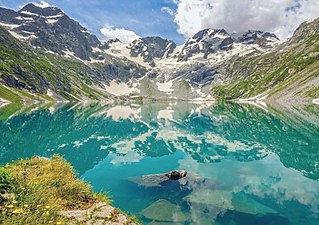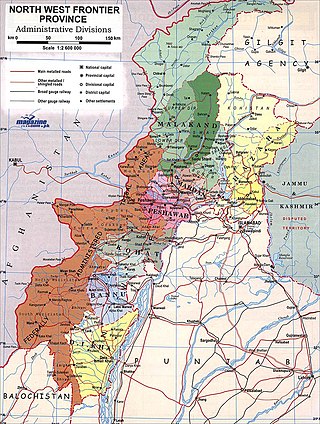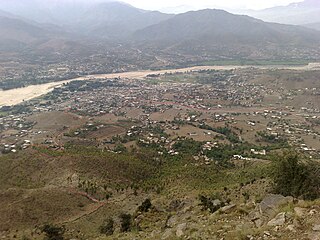The Yusufzai or Yousafzai, also referred to as the Esapzai, or Yusufzai Afghans historically, are one of the largest tribes of ethnic Pashtuns. They are natively based in the northern part of Khyber Pakhtunkhwa, to which they migrated to from Kabul during the 16th century, but they are also present in smaller numbers in parts of Afghanistan, including Kunar, Kabul, Kandahar and Farah. Outside of these countries, they can be found in Ghoriwala District Bannu, Balochistan Sibi (Akazai), Chagai (Hassanzai) and Rohilkandh.
Miangul Jahan Zeb HPk, HQA, CIE, also known as Miangul Abdul-Haq Jahan Zeb, was the Wāli of Swat from 1949 to 1969, a princely state that is now part of Pakistan. He succeeded his father, Wadud of Swat. He is remembered for building schools, hospitals, and roads, but also for his absolute rule over the region, which ended in 1969. When Pakistan came into being, Wadud of Swat declared the accession of Swat State to Pakistan on November 23, 1947. Muhammad Ali Jinnah, the Governor-General of Pakistan, accepted the Instrument of Accession on November 24, 1947. Wadud of Swat announced his resignation in favor of his son Jehanzeb. Jahanzeb also worked to protect the landmarks of previous cultures.

Amb or the Kingdom of Amb was a princely state in the present day Khyber Pakhtunkhwa region of Pakistan. Together with Phulra, it was known as Feudal Tanawal. ruled by Tanoli tribe a Royal Tenure start from Timurid Empire and end on Last Nawab Muhammad Farid Khan Tanoli, Amb was only Powerful state with Arms Civilized Military of 12,000 Mens, 300 Howitzer with there own Manufacturing Arms Factory Today Part of Pakistan army. Amb had a influence control roots in Swat, Dir and Chitral, A gaining of powerful roots of Amb military start from Second Anglo-Sikh War when East India Company provide military equipment to Jehandad Khan Tanoli to fight against Sikh, and then next Second anglo-Afghan War At the end of December 1947, the Nawab of Amb state acceded to Pakistan while retaining internal self-government. Amb continued as a princely state of Pakistan until 1969, when it was incorporated into the North West Frontier Province.

Ghazi Khan Umara Khan of Jandol, also called "The Afghan Napoleon", was a Pashtun chief on the north-western frontier of British India, who was chiefly responsible for the Chitral Expedition of 1895. Umar Khan started his series of conquest and battles from Dir, Swat, Bajaur, Kunar, Kafiristan and in 1892 Umara Khan attacked Chitral and occupied Chitral.

Bhopal State was an Islamic principality founded in the beginning of 18th-century India by the Afghan Mughal noble Dost Muhammad Khan. It was a tributary state during 18th century, a princely salute state with 19-gun salute in a subsidiary alliance with British India from 1818 to 1947, and an independent state from 1947 to 1949. Islamnagar was founded and served as the State's first capital, which was later shifted to the city of Bhopal.

Dir is a region in northwestern Pakistan in the Khyber Pakhtunkhwa, in the foothills of the Himalayas. Before the independence of Pakistan, Dir was a princely state, and it remained so until 1969 when it was abolished by a presidential declaration, and the Dir District was created the following year. The area covers 5,280 square kilometres. In 1996 Dir district was officially divided into Lower Dir District and Upper Dir District.

Malakand Division is an administrative division of Khyber Pakhtunkhwa province of Pakistan. It contains the following districts:

Lower Dir District is a district in the Khyber Pakhtunkhwa province of Pakistan. Timergara city is the district's headquarter. This district was formed in 1996, when Dir District was divided into Upper Dir and Lower Dir districts. Recently, On 22 January 2023, both Lower Dir and Upper Dir districts further bifurcated to create a new Central Dir District.

Upper Dir District is a district located in the Malakand Division of Khyber Pakhtunkhwa province of Pakistan. The city of Dir is its district headquarter. Geographically, it is located in the northern part of Pakistan. It borders with the Chitral district on the north, Afghanistan on the northwest, the Swat district on the east, and the Lower Dir district on the south. It shares 40 to 50 kilometers border with Afghanistan.
The Utmankhel is a Pashtun tribe present in Pakistan, with substantial numbers in Afghanistan. They lie between the Mohmands and the Ranizais of Swat, to the west and south-west of the junction of the Swat and Panjkora rivers. The Utmankhel mostly living in Malakand, Bajaur, Mohmand, Lower Dir, Mardan and Orakzai. The Utmankhel are Pashtuns, part of the Karlani tribal confederacy, who fought against British and Mughals emperors in Pakhtunkhwa. The British regarded the Utmankhel tribesmen as “warlike” peoples and one of the Martial Race. The Utmankhel are a tall, stout and fair race, but their dress and general customs have been assimilated by the neighboring peoples of Bajaur. Utmankhel speak the same dialect of Pashtu called Yousafzai Pashto.

The Malakand Agency was one of the agencies in the North West Frontier Province of British India and later of Pakistan until 2010. It included the princely states of Chitral, Dir and Swat, and an area around the Malakand Pass known as the Malakand Protected Area. The largest city in the area was Mingora, while the three state capitals were Chitral, Dir, and Saidu Sharif. In 1970, following the abolition of the princely states, the agency became the Malakand Division, which was divided into districts, one of which was the Malakand Protected Area, known as Malakand District. In 2000 the Malakand Division was abolished. Despite the constitutional changes since 1970, the expression Malakand Agency is still used, sometimes of the entire area of the former Agency, but more often of Malakand District.
The Wāli of Swat was the official title of the leader (wāli) of the Miangul dynasty that ruled over the state of Swat between 1857 and 1969.

Batkhela is a city, tehsil and the district headquarter of the Malakand District within the Khyber Pakhtunkhwa province of Pakistan. According to the 2017 Census of Pakistan, the population of Batkhela was recorded at 68,200. Batkhela is considered as one of the most popular business cities in the Khyber Pakhtunkhwa province. A water canal that pours into a small dam in the Jabban area near Batkhela is the main source of electricity production here.

Thana is the biggest city of Malakand District. The name is derived from the Pashto word "Thanrha" which means "Place Of Courting", and was a main political center during the tribal period. The literacy Rate in the city is approximately 95% and the poverty rate is approx 24%. The nominal GDP of the city Thana is approx $690 million. The area is 230 km (140 mi) and the elevation is 950 metres (3,120 ft). The average snowfall is 2.3 cm (0.91 in).

Dara Utmankhel, also known as Shaikhan, is a valley in the Lower Dir District of Khyber Pakhtunkhwa, Pakistan. It consists of nine villages: Maniband ما نی بند, Jabaghi جبګۍ, Zara Doghy زړه ډوګۍ, Kot Koshah کوټ کو شاه, Mandal Korona کورونه ماندل, Kot کوټ, Ghwandy غونډئ, Fazal Abad and Shah Kuronu شاه کو رونه. It lies in Timergara tehsil, east of the main road from Timergara to Dir. The inhabitants of this area belong to the Mandal, a clan of Utmankhel tribe of Pashtuns. The Utmankhel is one of the Karlanri Pashtun or Afghan tribes who appeared in concert with other tribes like Yousafzai and Tarkalani. They first settled in the areas of Malakand, Bajaur and Mohmand. These people were mainly associated with trade as the land was not suitable for agriculture.

The princely states of Pakistan were princely states of the British Indian Empire which acceded to the new Dominion of Pakistan between 1947 and 1948, following the partition of British India and its independence.
Miangul Abdul Wadud was the Wāli of Swat and grandson of the Akhund of Swat. He was elected Badshah Sahib (king) of Swat by a loya jirga held at Kabal in November 1918, and was recognized by the British authorities as ruler and formally installed as Wāli of Swat in Saidu Sharif on 3 May 1926. He ruled from 1918 to 1949, when he abdicated in favour of his eldest son, Miangul Jahan Zeb.

Manglawar is an administrative unit, known as Union council of Tehsil Babuzai, of Swat District in the Khyber Pakhtunkhwa province of Pakistan and former capital of Kingdom of Swat. It is located at 34°48'30.7"N 72°25'50.0"E with an average altitude of 987 meters.

Nawabzada Muhammad Shahabuddin Khan was the last Khan of Jandol, a princely state that is now part of Lower Dir District, Pakistan from 1947 to 1969. He is remembered for building schools, hospitals, forts and roads but also for his absolute rule over the region, which ended when Pakistan took control of Dir after local unrest.

The Dir Levies is a paramilitary force in the Dir District of the Pakistani province of Khyber Pakhtunkhwa. It operates as the primary law enforcement agency tasked with maintaining law and order within the division. The force has its origins back in the days of the British Raj, and has continued to function for over a century.

















